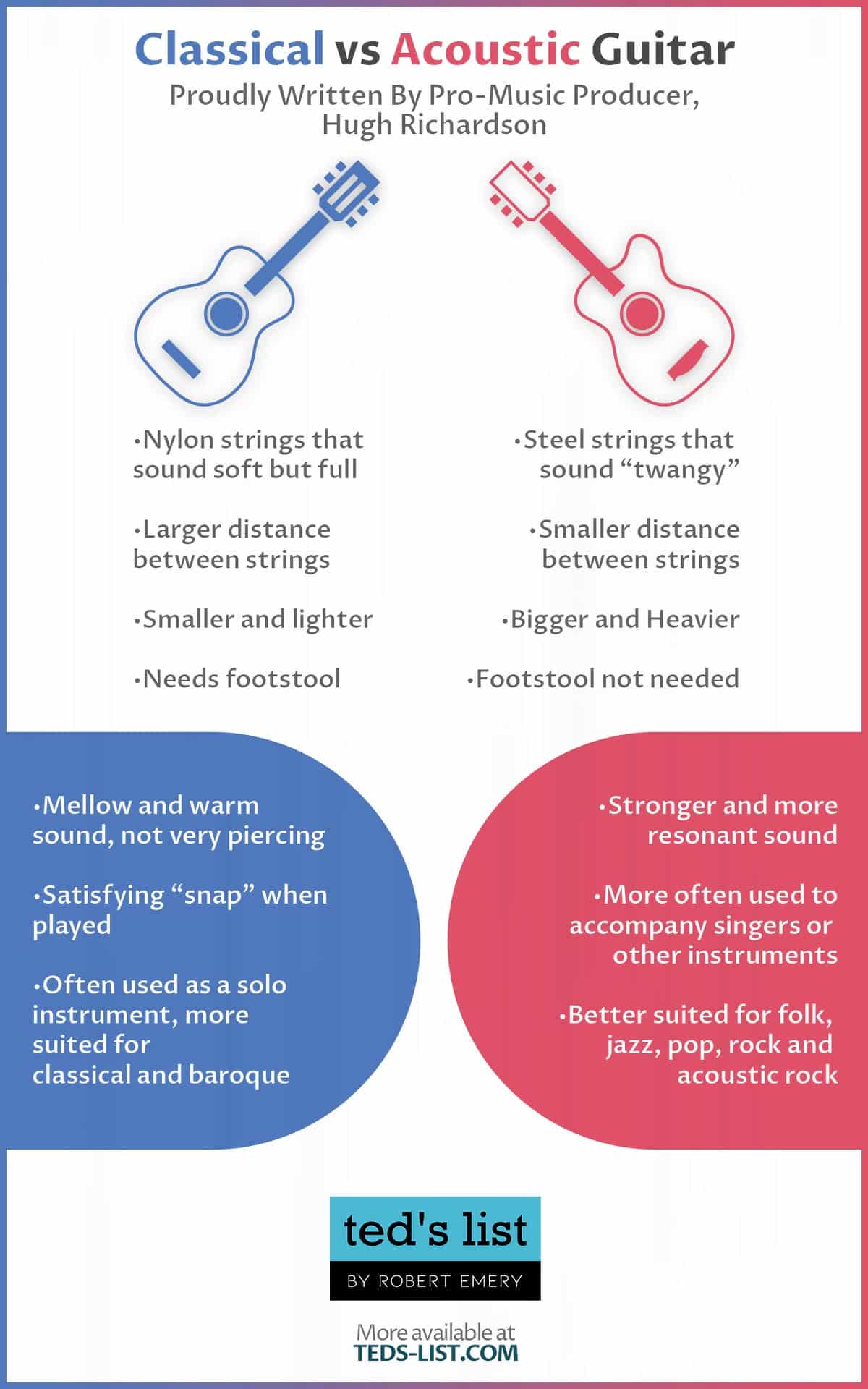Best Beginner
Classical Guitar
-
Overall: 10/10
-
Best Feature: Soft nylon strings
-
TedScore™: 10/10
Most Useful
Accessory
-
Overall: 10/10
-
Best Feature: Tunings and Capo Mode
-
TedScore™: 10/10
Best Beginner
Acoustic Guitar
-
Overall: 10/10
-
Best Feature: Premium kit for an affordable price
-
TedScore™: 10/10
Deciding between a **classical guitar** and an **acoustic guitar** felt like picking between a cosy cup of tea and a bold espresso – both perfect in their own ways.
Classical guitars, often played in a calm setting, have a graceful feel. Their nylon strings create a gentle, mellow sound perfect for fingerstyle playing. On the other hand, acoustic guitars bring energy into the room with their steel strings, which produce bold and vibrant sounds suitable for both strumming and fingerpicking.
It’s not just about the sound; how easy the guitar is to play is also essential, and each guitar has its unique feel that suits different styles and preferences.
So, stay with me, and I’ll show you how these lovely instruments are more than just wood and strings – they’re gateways to creative expression!
Classical Guitar vs Acoustic Guitar
As a guitarist, I’ve noticed the anatomical and constructional differences between classical vs acoustic guitars. Comparing them is like comparing cousins in the string family—similar, yet each has unique traits.
A classical guitar is usually easier to play than an acoustic guitar. The strings are easier to press down and are meant to be played with the fingers instead of a pick. Many beginners find using a pick tricky because they need to be used to hold it properly. However, using their fingers feels more natural.
Despite its initial challenges, the acoustic guitar is a versatile instrument that young students can adapt to and grow with, both musically and physically.
Its larger body may feel cumbersome at first, but as students mature, they’ll find it becomes as comfortable and manageable as the classical guitar they started with. This adaptability is a key advantage of the acoustic guitar, empowering students to take control of their musical journey.
Bodyshape
There are a few key differences in body shape between a classical nylon-stringed guitar and a regular steel-stringed acoustic guitar. For one, classical nylon-stringed guitars have a wider body than steel-stringed acoustics.
This is because the strings on a classical guitar are placed further apart, which requires a wider bridge and fret markers or fretboard. Additionally, the soundboard on a classical guitar is typically thinner than a steel-stringed guitar.
This allows the instrument to produce a softer, more delicate sound. Finally, classical guitars often have flowing curves and intricate inlays, while steel-stringed acoustics are more simple in design.
These differences in body shape and design give each type of guitar a unique sound and feel.
Strings
There are two main types of acoustic guitar strings: nylon and steel. Each has its own unique set of characteristics that can affect the sound of the guitar. Nylon string guitars are typically softer and have a mellow sound. They’re also easier on the fingers, making them a good choice for beginners.
Steel string guitars sound brighter and have more projection. They’re also thinner, which can make them easier to break. Because of this, they’re usually reserved for more advanced players.
Ultimately, choosing between nylon and steel strings is a personal preference. Different players will prefer different sounds, so you must experiment with both types to see which acoustic guitar strings you like best.

Sound
The nylon strings of a classical guitar have a much more mellow quality. They sound warm and full, but they aren’t very piercing.
They also provide something of a satisfying “snap” sound when played.
While describing in words is helpful, it’s often best to hear the sound for yourself.
Listen to classical guitar maestro Andres Segovia in this YouTube clip and see if you can hear the sound qualities I’m describing coming from his guitar.

Can you hear how mellow the nylon string guitars make the sound?
Can you hear the “snap” quality that comes from playing with fingers and nails?
By contrast, the acoustic guitar (sometimes known as a “steel string acoustic” because the strings are made from steel) sounds much more twangy, piercing, and aggressive.
Listen to this YouTube clip of acoustic guitar legend Tommy Emmanuele to see if you can hear these sound qualities. You can really hear the twang of the steel strings, which have an almost growl-like quality.
You may also notice that steel-string acoustic guitars sound more resonant and project their sound with more strength and clarity than classical guitars do.
This is because they have a larger body, and part of that larger body is having a larger soundbox. This means there’s more mass for the guitar to vibrate and a bigger space for it to vibrate in. This is what gives the best acoustic guitar resonance.
Similarities between acoustic and classical guitar
When most people think of guitars, they picture either acoustic guitars or electric guitars. However, there is another type of guitar that is often overlooked: the classical guitar. Classical guitars are very similar to acoustic guitars in many ways.
For example, both types of guitars have six strings and are played with a pick. However, there are also some important differences between the two.

For instance, classical guitars generally have a wider neck than acoustic guitars, which makes them better suited for finger-picking. In addition, classical guitar strings typically are nylon strings, while acoustic guitars have steel strings.
As a result, classical guitars have a softer, more mellow sound than their acoustic counterparts.
Despite these differences, classical and acoustic guitars share many common features, and both can be used to create beautiful music.
Differences between acoustic and classical guitar
Many wonder, “Which is harder to learn classical or acoustic guitar?”
Well, the level of difficulty in learning classical versus acoustic guitar can vary based on individual preferences and playing styles. Classical guitar playing often involves fingerstyle techniques and intricate classical music repertoire, which may require a different approach and discipline than playing acoustic guitar, mainly if the acoustic guitar is used for strumming chords in popular music.
Both styles have unique challenges, and the difficulty of learning each largely depends on the player’s musical goals and dedication to practice.

Sound difference between acoustic guitar vs classical guitar
The difference between acoustic and classical guitars lies in the type of strings they use. Acoustic guitars typically have a steel string, while classical guitars have nylon strings.
This gives acoustic guitars a brighter, more twangy sound, while classical guitars have a softer, mellow sound. In addition, acoustic guitars generally have a smaller body than classical guitars, which gives them a warmer sound.
Finally, the two types of guitars are played differently: classical guitarists use many finger-picking techniques, while acoustic guitarists tend to strum more chords. All of these factors combine to create two very distinct sounds.
Which is the best choice between acoustic or classical for the genre of music you want to play
To help you figure out which type of guitar is the best choice for you and the kind of music you want to play guitar
Let’s look next at the various pros and cons of playing guitar and learning each instrument.

Classical guitar pros
Classical guitar has been gaining popularity in recent years as a solo instrument. Its popularity is due largely to the fact that it is relatively easy to learn how to play, and it is a very versatile instrument.
A classical guitar can be used for a wide range of genres, from classical music and Spanish music to pop music and jazz. It is also a very portable instrument, so it is easy to take with you wherever you go. If you are thinking about learning how to play classical guitar, here are some of the pros that you can look forward to:
- You will be able to play a wide range of genres.
- It is a very portable instrument.
- Classical guitars are relatively affordable.
- It is a relatively easy instrument to learn how to play.
Classical guitar cons
There are a few cons to playing classical music with guitar, the most noteworthy being the amount of time it takes to learn. Many guitarists give up because they need to see results faster. Classical guitar is an intricate and delicate style that takes years of practice to master. The other big con is the cost of classical guitars.
They are typically made with higher-quality materials than regular guitars so that they can be pretty expensive.
If you’re not careful, you could easily spend more on your instrument than you ever would have made in music or guitar lessons.
Lastly, classical guitars can be fragile and require extra care when Tuning and handling. With all that said, I would still highly recommend learning classical guitar to any passionate music lover. The rewards definitely outweigh the drawbacks!

Acoustic guitar pros
There are many reasons to learn how to play acoustic guitar. For one, it is a widely popular instrument that is used In all music genres as a result, learning acoustic guitar can help you to appreciate a wider range of music.
In addition, an acoustic guitar is relatively easy to learn how to play, and it can be a great way to relax and de-stress. Moreover, playing acoustic guitar can be a great way to meet new people and make friends.
Finally, learning how to play acoustic guitar can be a great way to boost your self-confidence. Whether you are looking to improve your musical skills or simply want to find a new hobby, learning acoustic guitar is sure to offer plenty of rewards.
Acoustic guitar cons
Learning acoustic guitar has some cons. First, it can be more expensive than other kinds of guitars. Second, it can be harder to find a guitar that’s the right size for you. Third, you might have to put more effort into learning guitar and how to play it because it doesn’t have as many features as other kinds of guitars.
Fourth, you might not be able to play as loud as you want with an acoustic guitar. Finally, you might not be able to play all the songs you want to play with an acoustic guitar. These are all things to keep in mind if you’re thinking about learning acoustic guitar.
Classical vs Acoustic Guitar
Summary
Acoustic vs classical guitar: What’s the difference?
The primary difference between classical and acoustic guitars lies in their construction and playing styles.
- Classical guitars feature nylon strings and a wider neck, while acoustic guitars typically have steel strings and a narrower neck, catering to different musical genres and playing techniques.
- Acoustic guitars produce a bright, versatile sound, while classical guitars offer a warm, rich tone.
- Acoustics are often used in pop, folk, and country genres, while classicals are favored for classical and flamenco music.
Both have distinct body shapes and string types, catering to different playing styles. Acoustic guitars are a good option for beginners willing to practice and learn scales, chords, progressions, and chord changes to quickly improve their skills.
Ultimately, the most important thing is that the instrument makes you want to play it and brings you joy, regardless of your choice
FAQ's
The primary difference between classical and acoustic guitars is their construction and playing styles. Classical guitars typically have nylon strings and a wider neck, while acoustic guitars have steel strings and a narrower neck.
A classical guitar is an acoustic guitar designed explicitly for classical music. It typically features nylon strings, a wide neck, and a flat fingerboard and is known for its warm, mellow tone. Classical guitars are commonly used in classical, flamenco, and fingerstyle music.














☝️🤪Cool